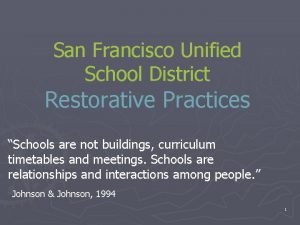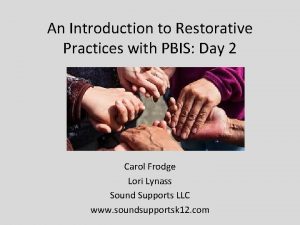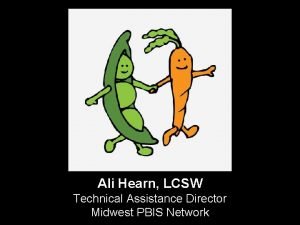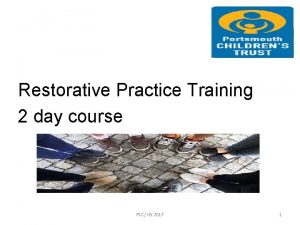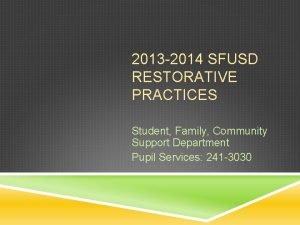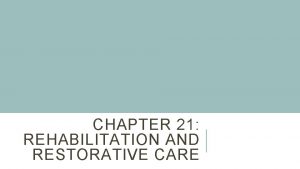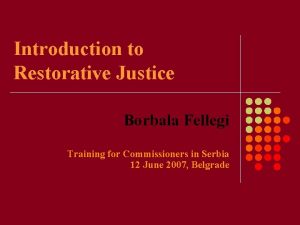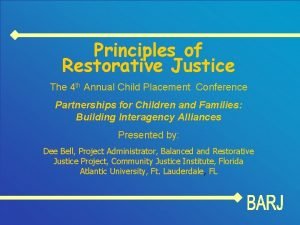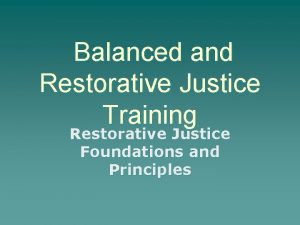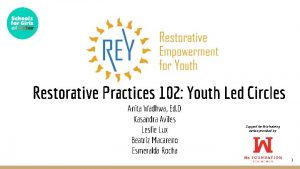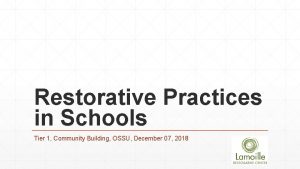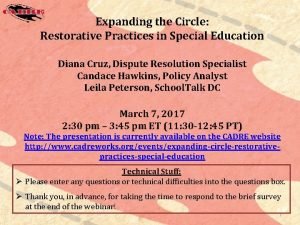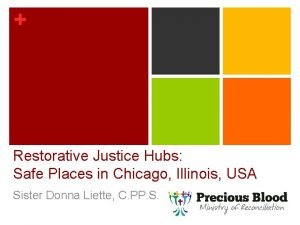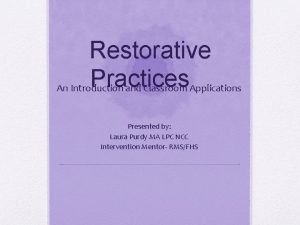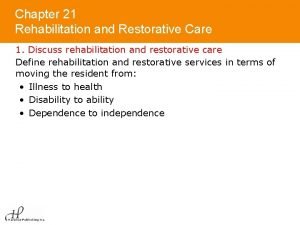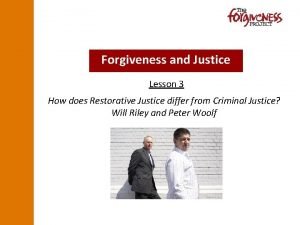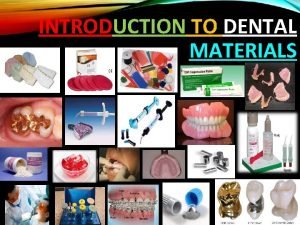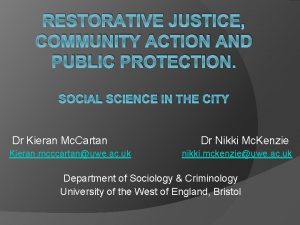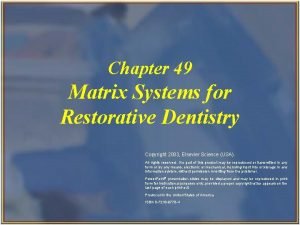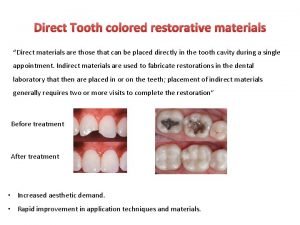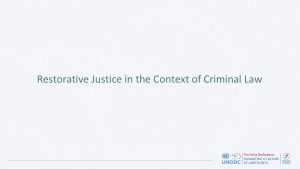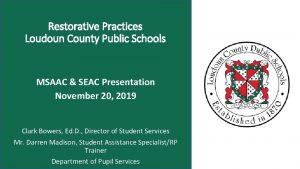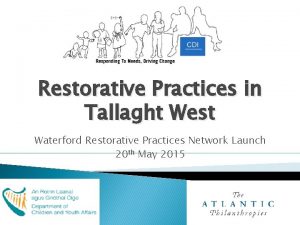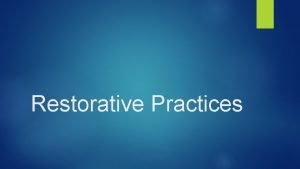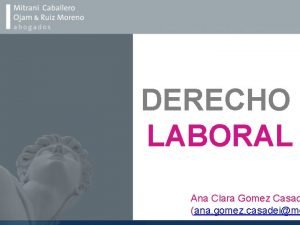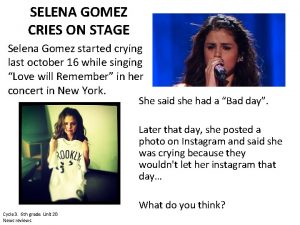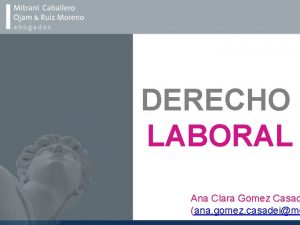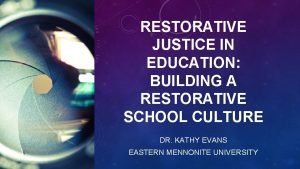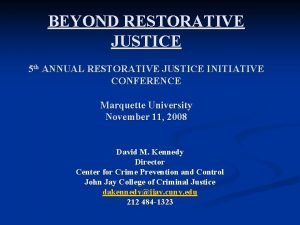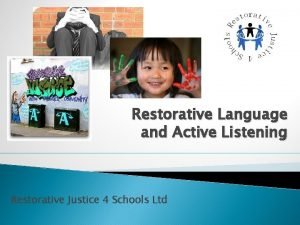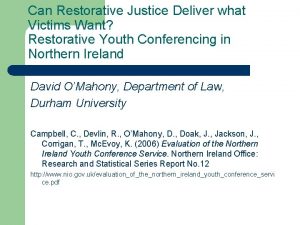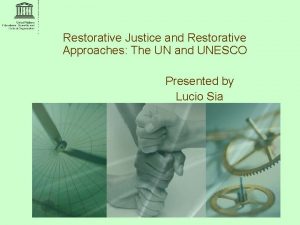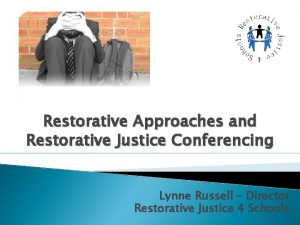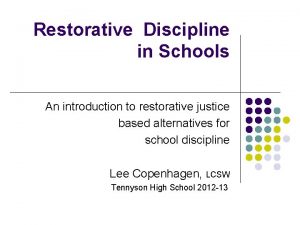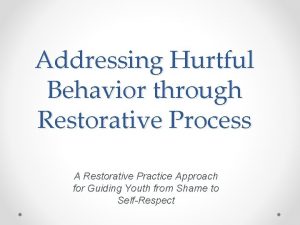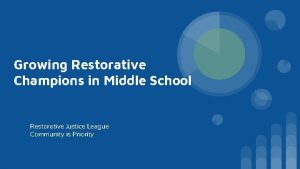RESTORATIVE PRACTICES Dr Mariana Gomez mariana gomezsweetwaterschools org






















- Slides: 22

RESTORATIVE PRACTICES Dr. Mariana Gomez mariana. gomez@sweetwaterschools. org Armando Melendrez armando. melendrez@sweetwaterschools. org

Objectives Participants will gain understanding in the following: ➢Why Restorative Practices? ➢What are Restorative Practices? ➢Circles as a component of Restorative Practices Adapted from IIRP

Dr. Fulcher’s May 2016 Presentation LISTENING CAMPAIGN THEMES • General Trends • Student Support/Resources • Leadership • CTE/ROP/More Course Options • English Language Learners • Identifying Student Needs • East/West Comparisons • Relationship Building • Counseling, Mental and Physical Health

Dr. Fulcher’s May 2016 Presentation PROPOSED FUTURE ACTION • • NCRC Partnership • Mediations • The Art of Inclusive Communication (students and staff) International Institute of Restorative Practices Training National Equity Project (staff awareness building and professional development) Culturally Courageous Conversations (principal training) Restorative Practices (four introductory schools) Professional Development (school culture and climate) Equity-Based Resource Allocations… SDCOE Partnership (Restorative Justice supports)

Ice-Breaker PAIR SHARE *One concern *One thing you are grateful for Adapted from IIRP

Fundamental Hypothesis Restorative Practices The fundamental hypothesis of restorative practices is that human beings are happier, more cooperative and productive, and more likely to make positive changes in their behavior when those in positions of authority do things with them, rather than to them or for them. Adapted from IIRP

Aim of Restorative Practices in School Communities To develop community and to manage conflict and tensions by repairing harm and restoring relationships. Adapted from IIRP

If A Child Doesn't Know How: The Role Of An Educator “If a child doesn’t know how to read, we teach. ” “If a child doesn’t know how to swim, we teach. ” “If a child doesn’t know how to multiply, we teach. ” “If a child doesn’t know how to drive, we teach. ” “If a child doesn’t know how to behave, we. . . teach? …punish? ” Why can’t we finish the last sentence as automatically as we do the others? Tom Herner, 1998 Adapted from IIRP

Social Discipline Window Adapted from IIRP

Social Discipline Window Reflect on one parent/guardian that raised you. Where on the social discipline window would you place your parent/guardian when you reflect on how you were disciplined/supported? Adapted from IIRP

Social Discipline Window Reflect on a mentor/adult that had a significant impact in your life. Where on the social discipline window would you place your mentor when you reflect on how you were disciplined/supported? Adapted from IIRP

Fair Process “…individuals are more likely to trust and cooperative freely with systems – whether they themselves win or lose by those systems – when fair process is observed. Adapted from IIRP

FAIR PROCESS: WHAT IT ACHEIVES Builds Trust Knowledge Sharing Beyond Duty Voluntary Cooperation Drives Performance Adapted from the original version from the International Institute for Restorative Practices Curriculum 13

Compass of Shame Adapted from IIRP

Responding to Shame Respond to others experiencing shame by: ➢Listening to what they have to say ➢Acknowledging their feelings ➢Encouraging them to talk about their experience Adapted from IIRP

STIGMATIZING VS. REINTEGRATIVE SHAME Stigmatizing Shame: Pushes the offender out of the community and labels them. The offender is now a bad person who committed a crime or harm. This label may follow them their whole lives. Since the offender is pushed out of the community it encourages their participation in a criminal subculture. Reintegrative Shame: Expresses disapproval but does not push the offender out of the community. This type of shame rejects the act but not the person and allows for the person to be reintegrated back into the community. Adapted from the original version from the International Institute for Restorative Practices Curriculum 16

Restorative Practices Continuum ININFORMAL affective statements conference FORMAL affective questions small impromptu group formal or circle conference FORMAL affective statements conference affective questions small impromptu group or circle formal conference Adapted from IIRP

Restorative Question 1 To respond to challenging behavior ➢ What happened? ➢ What were you thinking of at the time? ➢ What have you thought about since? ➢ Who has been affected by what you have done? In what way? ➢ What do you think you need to do to make things right? Adapted from IIRP

Restorative Question 2 To help those harmed by others’ actions ➢ What did you think when you realized what had happened? ➢ What impact has this incident had on you and others? ➢What has been the hardest thing for you? ➢What do you think needs to happen to make things right? Adapted from IIRP

Restorative Circles Restorative Practices in Oakland Schools: Community Building Circle Adapted from IIRP

Restorative Circles ▪ 3 General Types – Sequential, Non-Sequential and Fishbowl ▪ Talking Piece ▪ Check-In & Check-Out ▪ Ice-Breakers ▪ Course Content ▪ Behavior Expectations ▪ Student/Staff Community Adapted from IIRP

Restorative Practices in SUHSD Year One – Introducing RP District-Wide • District-Wide Staff Trainings • Site-based PD Staff Overview • District RP Trainers • Four Pilot Schools Alternative to Suspension (ATS) Pilot Study Classroom Observations Teacher feedback Student feedback • Restorative Conferencing Adapted from IIRP
 Sfusd restorative practices
Sfusd restorative practices Pbis and restorative practices
Pbis and restorative practices Ali hearn
Ali hearn Social discipline window
Social discipline window Sfusd restorative practices
Sfusd restorative practices Chapter 21 rehabilitation and restorative care
Chapter 21 rehabilitation and restorative care Restorative wedelstaedt
Restorative wedelstaedt Restorative mini cf
Restorative mini cf Principle of restorative justice
Principle of restorative justice Equilibrium restorative balance
Equilibrium restorative balance Restorative circle script
Restorative circle script Restorative practice
Restorative practice Restorative practice circle questions
Restorative practice circle questions Restorative justice hubs chicago
Restorative justice hubs chicago Circle norms
Circle norms 21 rehabilitation and restorative care
21 rehabilitation and restorative care Peter woolf restorative justice
Peter woolf restorative justice Ideal requirements of dental materials
Ideal requirements of dental materials Restorative care versus rehabilitation
Restorative care versus rehabilitation Social justice and community action
Social justice and community action Types of matrix bands in dentistry
Types of matrix bands in dentistry Tooth colored restorative materials
Tooth colored restorative materials Principles of restorative justice
Principles of restorative justice
